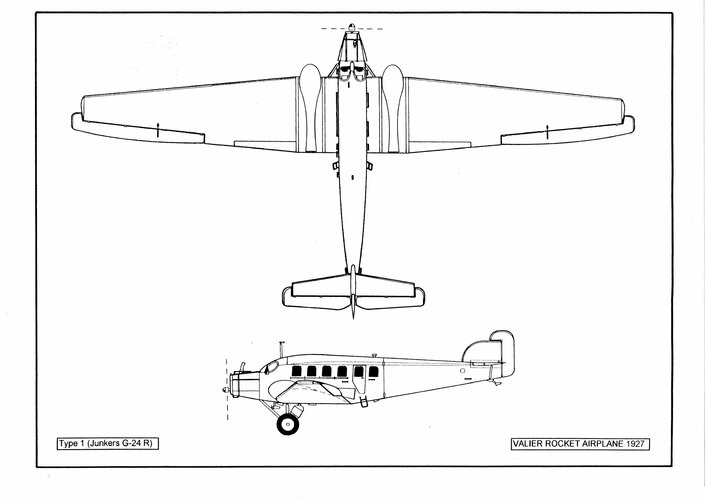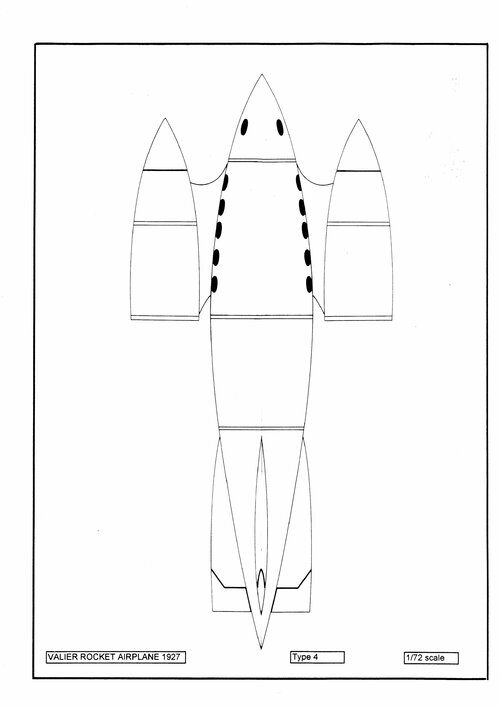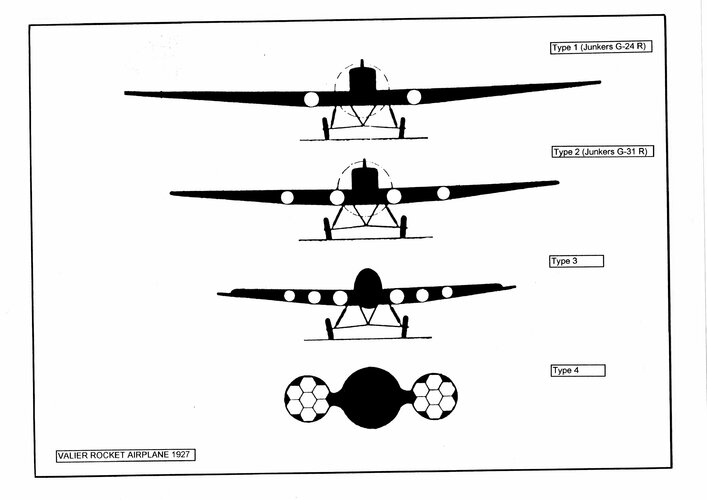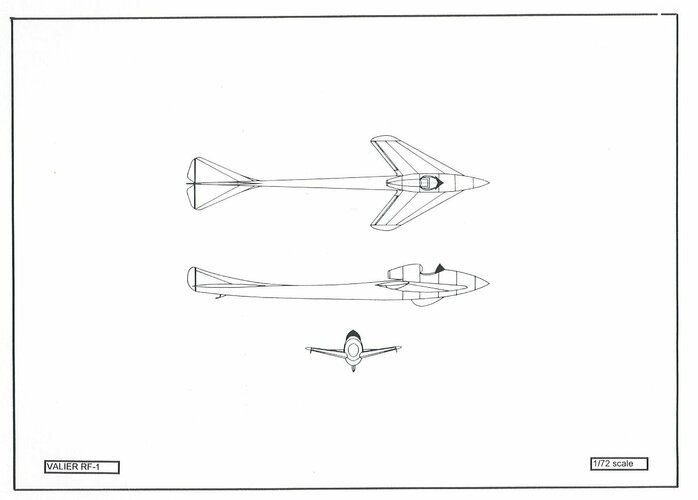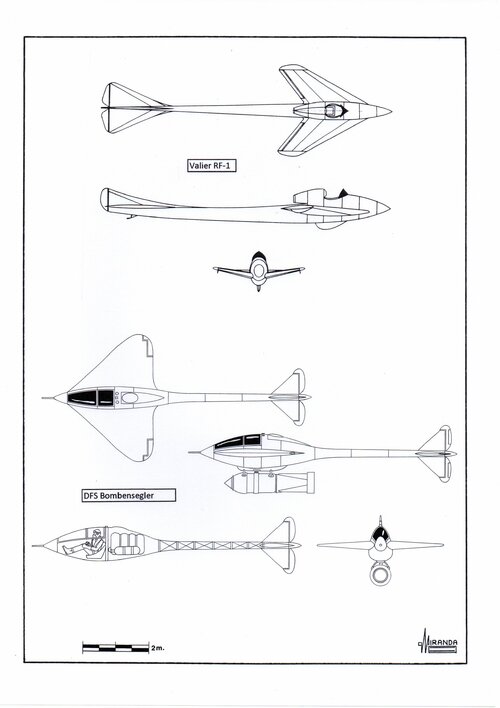You are using an out of date browser. It may not display this or other websites correctly.
You should upgrade or use an alternative browser.
You should upgrade or use an alternative browser.
Valier rocket airplane 1927
- Thread starter Justo Miranda
- Start date
- Joined
- 11 March 2006
- Messages
- 8,612
- Reaction score
- 3,090
Could this be the source of the Lippisch "Gleiter Bombenflugzeug" /"Silent Dart" ?
https://www.secretprojects.co.uk/threads/lippisch-glider-bomber.3042/#post-47139
https://www.secretprojects.co.uk/threads/lippisch-glider-bomber.3042/#post-47139
Could this be the source of the Lippisch "Gleiter Bombenflugzeug" /"Silent Dart" ?
https://www.secretprojects.co.uk/threads/lippisch-glider-bomber.3042/#post-47139
- DFS/Lippisch Bombensegler
In July 1945, an American officer named Richard Rex, seeking souvenirs in the Reichs Chancellery, found a portfolio of drawings representing the project of an odd airplane in the form of dart. After being analyzed by leading aviation expert Terry Gander, who confirmed the authenticity of the material, the drawings were published in an article titled 'Hitler's Kamikaze' in the journal 'World War Investigator' in May 1988. The editor of the magazine 'Flypast' also analyzed the original material, concluding that there would have not been an effective weapon, mainly because of the difficulty of using a balloon as airbrake.
The subject seemed interesting and we decided to include it in our books 'Die Geheimen Wunderwaffe des III Reiches' and 'Wonder Secret Weapons of the Third Reich' in 1995 and 1996. In 2002, authors Dieter Herwig and Heinz Rode also included it in his book 'Geheim Projekte der Luftwaffe, Band III'. On December 13, 2008, the original drawings were auctioned by International Autograph Auctions Ltd, at the Radisson Edwardian Heathrow and sold by 4,500 US Dollars. The sale was covered by the media with articles published in Flight Global, The Sun and Daily Mail and the issue was discussed at the highest level by the experts of www.secretprojects.co.uk forum.
The conclusion was that the pictures did not come from any 'official' design team due to the type of paper used and were probably the work of an amateur, which does not invalidate its authenticity or originality of the idea. Also, an accurate translation of texts in German, analyzed by Michel Van and Jens Baganz, revealed technical inconsistencies and the possibility that they were added 'a posteriori'. The final verdict was that the drawings were the work of an amateur, which does not invalidate its authenticity or originality of the idea.
Since then, the project has been defined as Segler-Bomber, Gleiter Bombenflugzeug, 'Glider Bomber', DFS Bombsegler, 'Bomb-Carrying Glider', 'Hitler's Silent Dart', 'Lippisch Glider Bomber', Lippisch Gleiter-Bombenflugzeuge and our favourite ,'Hitler's pub dart bomb'. The anonymous author also causes difficulties to authors that sort alphabetically the project. For 28 years, experts have given an opinion, we authors have published and scale models manufacturers have marketed replicas for collectors of the 'Luft 46' theme, with no new information having emerged about this project. We may only add some responsible speculation.
A comparative study based on the size of the antiship bomb SC 1000 allows us to assume that the wing span of the glider would be 3.67 m, the overall length of 7.68 m and the wing area of 5 sq m. The internal structure of the fuselage, of cantilever type with internal tensors, could be made of steel as well as the external cladding. The wings and tail surfaces would probably be built in wood/plywood to avoid the use of strategic materials. The overall weight should not exceed 1,700 kg to be transported under a Ju 88 bomber using the ETC 502 or ETC 504 bomb racks and would be launched from 25,000 ft at about 10 km. the target.
It was expected that it would reach about 1,000 kph during terminal dive, launch the bomb at 700 m from the warship and initiate a path of upward flight at high-g to avoid collision. The instrument board contained an airspeed indicator, an altimeter and an artificial horizon. The bombsight device was a simple glass plate with an aiming grid positioned over the instrument board. The rest of the equipment consisted of an oxygen bottle, an electric battery and a telephonic link with the mother plane. Behind the cockpit, there was a storage space containing a folded balloon and two bottles of hydrogen to inflate the balloon.
Original documents do not specify which would have been the fate of the pilot after the attack; it may be speculated that he would try to land over the sea and that the floating structure of the wing would allow him staying on the surface, although the rescue by a U-boat, a flying boat or an Allied destroyer seems quite improbable. The use of the balloon as airbrake would have been impossible at high speed, but it might have been conceived as the air-to-sea rescue system similar to the popular one shown in the last few minutes of the film 'Thunderball' of 1965. This system was called 'Skyhook' and was used during the Cold War by the U.S. Navy and the CIA to rescue pilots and to extract agents. The officer in the ground used a harness attached to a helium balloon of 17 cubic meters through a nylon cord of 150 m. The rescue plane used to be a B-17 or a Lockheed 'Neptune', with wire-catching horns mounted to the extreme nose that caught the cable, freed the balloon and hoisted the man using an electric powered winch. Afterwards, the flight crew tried to let it inside through a ventral hatch using a boat-hook.
In later years the system was perfected to collect airborne drones and satellites descended by parachute. As for the possible origins of the glider-bomber, it should be noted that the shape and size are similar to those of the RF-1, a project of rocket plane designed by Max Valier in 1929 to the purpose of crossing the Channel in a four minutes record flight. The shape of the wing of the glider-bomber seems inspired by the Überschall Delta designs used as wind tunnel models by Professor Alexander Lippisch on his research about supersonic flight.
Attachments
Lippish was a glider.Might that design work better in a thicker atmosphere?
Similar threads
-
-
Curtiss Mystery Five-Wing Hover Airplane Concept of 1927
- Started by hesham
- Replies: 8
-
Valier-Lippisch Vehicle 2 - 1/43 resin auto miniature
- Started by jzichek
- Replies: 5
-
Louis Wattier Transatlantic Flying Boat Project of 1927
- Started by hesham
- Replies: 6
-

